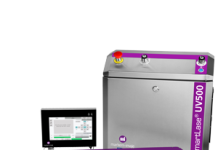Ipex will ensure that the 2014 event reflects major trends within the industry. Based on findings of a global market study, Ipex will focus on the growth sectors of print, including digital, packaging and international PSPs (emerging markets) as well as on emerging trends, including Cross Media. The duration of the event has also been shortened.
Ipex organisers commissioned AMR International in 2012 to undertake a global market study on the key trends impacting the industry and the events that serve it and the results have been used to formulate a White Paper, which includes an overview of how Ipex is responding to ensure the 2014 event reflects the industry.
The study showed that Ipexs exhibitors and visitors are moving their business in new directions, and Ipex will mirror this change so that it can provide printers worldwide with solutions and ideas that address the challenges and opportunities their businesses face.
Ipex’s digital focus will address packaging PSPs’ shift towards digital methods. Digital printing is growing in mature and emerging markets, with a compounded annual growth rate of 9.2% from 2009 to 2014.
The duration of Ipex has been shortened to six days (24-29 March), to lower on-site costs for exhibitors and make the event more accessible to smaller, innovative suppliers.
Ipex 2014 will integrate Cross Media to showcase the latest print and communications for marketing and publishing campaigns, bringing together the whole print and media supply chain.
The organisers will also place a significant focus on delivering a comprehensive, thought provoking and inspirational content programme. This will include the World Print Summit, which will follow the theme of ‘Strategies & Practices of Outstanding Leadership in the Challenging Business of Offline and Online Marketing’, where thought leaders from within and surrounding the print industry will come together to address the big issues and opportunities they face.
The seven key trends impacting the printing industry and the events that serve it that emerged from the study include:
• Consolidation in the PSP community in developed economies.
• Decline of litho in developed markets:
Forecasts indicate that for the foreseeable future, offset printing revenues will continue to grow in Asia, Latin America and Eastern Europe, but in very low single figures, while all other regions show decline (Source: Pira International).
• The rise of digital:
Digital printing revenues are forecast to have increased by 56% by 2014, while offset will have experienced a 7.3% decline over the same period (Source: Pira International).
• Printers offering non print-related services:
As printed media continues to face competition from electronic media, printing companies are also seeking to provide services in other channels. For example, publication printers are offering electronic publishing, while printers of marketing materials are evolving into full marketing service providers which offer end-to-end, cross-channel marketing to corporate clients.
• Growth in printed packaging:
Insulated from the shift to e-media, packaging is the only print product segment forecast to grow to 2014. Packaging is forecast to grow by 3.4% from 2009 to 2014.
• Growth in emerging markets:
The combined value of the Asian, Middle Eastern, Latin American and other emerging print media economies is forecast to grow in value from R2.4 trillion ($273 billion) in 2011 to R2.7 trillion ($303 billion) in 2014. That will represent close to half of the global print economy, compared with just 37% in 2007 (Source: Pira International).
• Interest in cross media/multi-channel marketing.
If they are to meet the full breadth of their clients’ needs, PSP and agency suppliers must also operate across both channels. As a result, a class of PSPs is evolving to become marketing service providers (MSPs) with multi-channel capabilities.
Trevor Crawford, Event Director, Ipex 2014, said, Ipex is moving from being a general print event to a highly focussed multimedia experience promoting the essential role of print. It is driven by an impressive content programme to inspire print service providers to add value and increase profitability, and recognise the importance of collaboration with end users. This is an exciting development in Ipex’s history.
Now that Ipex has a clear digital and print communications direction, the logical conclusion would be to change the dates so that the multi-layered content programme can run throughout the event. After careful review of the research and consultations with the IAC, the decision was made to reduce the days to bring it in line with other major industry events today and ensure that we deliver a dedicated, ‘must-attend’ event that meets the needs of senior decision makers.





















